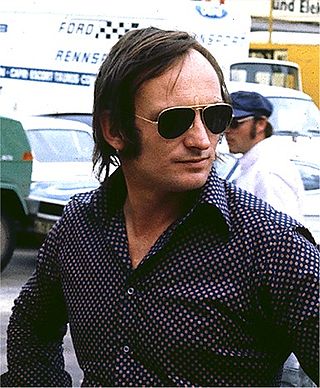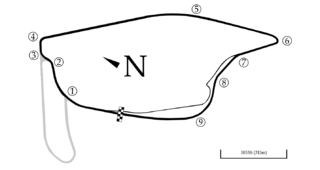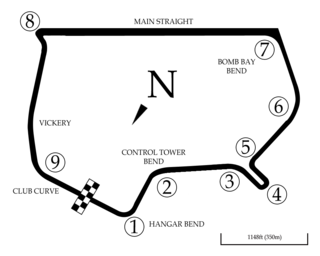
Denis Clive Hulme was a New Zealand racing driver, who competed in Formula One from 1965 to 1974. Nicknamed "The Bear", Hulme won the Formula One World Drivers' Championship in 1967 with Brabham, and won eight Grands Prix across 10 seasons.

Christopher Arthur Amon was a New Zealand racing driver and motorsport executive, who competed in Formula One from 1963 to 1976. Widely regarded as one of the greatest drivers to never win a Formula One Grand Prix, Amon won the 24 Hours of Le Mans in 1966 with Ford, as well as the 24 Hours of Daytona in 1967 with Ferrari.

Formula 5000 was an open wheel, single seater auto-racing formula that ran in different series in various regions around the world from 1968 to 1982. It was originally intended as a low-cost series aimed at open-wheel racing cars that no longer fit into any particular formula. The '5000' denomination comes from the maximum 5.0 litre engine capacity allowed in the cars, although many cars ran with smaller engines. Manufacturers included McLaren, Eagle, March, Lola, Lotus, Elfin, Matich and Chevron.

Pukekohe Park Raceway was a former FIA Grade 3 car racing track that was situated on the outside of the Pukekohe Park Thoroughbred Racetrack, located in the surrounds of Pukekohe.
Graeme Harry Lawrence is a race car driver from New Zealand. He started serious motor racing in the National 1.5 litre series winning the series decisively in 1968 ahead of David Oxton and Ken Smith. Lawrence then ran half a European F2 series in an uncompetitive semi works F2 McLaren, he found the racing harder than expected and was shaken, by his experience racing in Germany at the Hockenheim race in the rain, were Jim Clark was killed. McLaren allowed Lawrence to build up another F2 chassis in his works and was 2nd in the SR Gold Star series in the car, and first ST driver home in the Tasman races at Pukekohe and Levin.
The 1964 Tasman Series was an international motor racing series contested in New Zealand and Australia over eight races beginning on 4 January and ending on 2 March. It was the first Tasman Series. The series, which was officially known as the Tasman Championship for Drivers, was organised jointly by the Association of New Zealand Car Clubs Inc. and the Confederation of Australian Motor Sport with the winning driver awarded the Tasman Cup. The championship was open to racing cars using unsupercharged engines of up to 2,500 c.c. capacity.

The New Zealand Grand Prix, sometimes known as the New Zealand International Grand Prix, is an annual motor racing event held in New Zealand. First held in 1950, it is best known for hosting rounds of the Tasman Series in the 1960s and 1970s. It is currently run as the signature race of the Formula Regional Oceania Championship.

The 1964 New Zealand Grand Prix was a race held at Pukekohe Park Raceway on 11 January 1964. The race had 16 starters.

The 1965 New Zealand Grand Prix was a motor race held at the Pukekohe Park Raceway on 9 January 1965. The race was held over 50 laps of the 3.5 km (2.2 mi) combined circuit for a total distance of 175 km (110 mi). The Grand Prix was run for open wheel racing cars, specifically conforming to either the 2.5 litre Tasman Formula regulations or the 1.6 litre New Zealand National Formula regulations.

The 1966 New Zealand Grand Prix was a race held at the Pukekohe Park Raceway on 8 January 1966. The race had 19 starters.

The 1967 New Zealand Grand Prix was a race held at the Pukekohe Park Raceway on 7 January 1967. The race had 19 starters.

The 1968 New Zealand Grand Prix was a race held at the Pukekohe Park Raceway on 6 January 1968. The race had 21 starters.

The 1969 New Zealand Grand Prix was a race held at the Pukekohe Park Raceway on 4 January 1969. The race had 20 starters.

The 2000 New Zealand Grand Prix event for open wheel racing cars was held at Pukekohe Park Raceway near Auckland on 2 December 2000. It was the forty-sixth New Zealand Grand Prix and was open to Formula Holden cars. This was the first time the marque event had been held at the Pukekohe circuit since 1991, and following the demolition of the circuit in 2023, it would also prove to be the last time the event would be held here.

The 1971 New Zealand Grand Prix was a race held at the Pukekohe Park Raceway on 9 January 1971. The race had 20 starters.

The 1972 New Zealand Grand Prix was a race held at the Pukekohe Park Raceway on 8 January 1972. The race had 20 starters.

The 1973 New Zealand Grand Prix was a race held at the Pukekohe Park Raceway on 6 January 1973. The race had 20 starters.

The 1974 New Zealand Grand Prix was a race held at the Wigram Airfield Circuit on 19 January 1974. The race had 20 starters. This was the first and only New Zealand Grand Prix to be held at the Wigram Airfield Circuit, and the race was also the 1974 Lady Wigram Trophy. The race was moved to Wigram from the usual Pukekohe to be part of the Commonwealth Games being held in Christchurch.

The 1975 New Zealand Grand Prix was a race held at the Pukekohe Park Raceway on 12 January 1975. The race had 20 starters.

The 1976 New Zealand Grand Prix was a motor race held at Pukekohe Park Raceway on 4 January 1976. The race, which had 12 starters, was the opening round of the 1976 Peter Stuyvesant Series.









